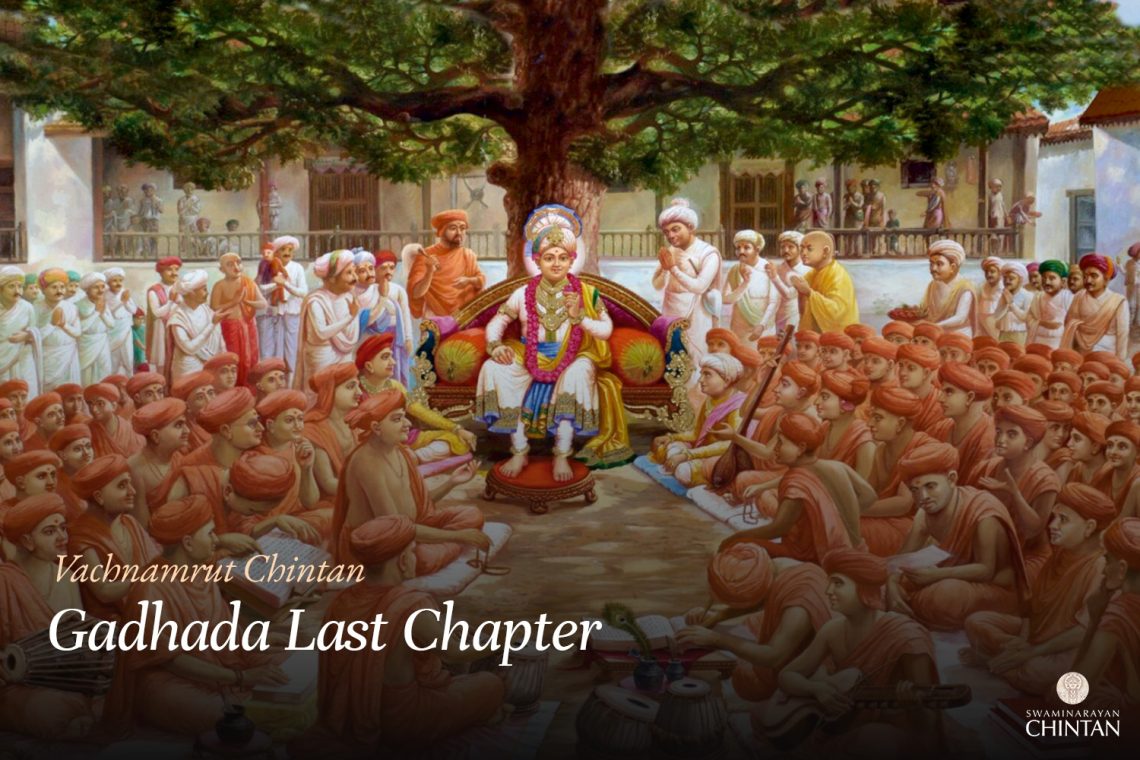Central Insights:
- Compassion (Daya) and Affection (Sneh).
Key Points:
- A devotee who, during the stage of spiritual practice, remains connected to holy fellowship (Satsang) retains Daya and Sneh for Bhagwan and His devotees even after becoming Brahm-roop (one with Brahm).
- If influenced by evil company (Kusang), one does not retain Daya and Sneh for Bhagwan and His devotees.
- Daya and Sneh directed toward Bhagwan or His devotees are virtuous traits.
- Daya and Sneh extended toward non-devotees or unworthy individuals are considered flaws.
Explanation:
In this Vachanamrut, Shreeji Maharaj initially discusses that the heart of a devotee naturally possesses Daya and Sneh. Of these, Sneh resembles honey, which sticks everywhere, while Daya is inclined to extend itself broadly. When Bharat showed compassion (Daya) toward a fawn, it led to his rebirth as a deer. Wherever compassion arises, it invariably brings affection (Sneh) along with it. The remedy to overcome the bindings of Daya and Sneh is through Atmagnan (knowledge of the Self) and Vairagya (non-attachment). These two virtues can eliminate Daya and Sneh, thereby freeing one from the influences of the three bodies and their afflictions, leaving only the pure essence of Brahm.
The question arises: does a liberated soul (Mukt) who has achieved Atmagnan and Vairagya still retain Daya and Sneh for Bhagwan and His devotees? In essence, can the effects (like compassion and affection) persist even when the causes (worldly attachments) have been eradicated? Various learned saints responded, but Maharaj was not fully satisfied with their answers.
Maharaj then explained that when a devotee transcends Maya’s influences through Jnan and Vairagya, they reach a state of pure Brahm. In this state, they are not bound by Maya, nor are they subject to the ties of Daya and Sneh. Maharaj illustrated this with the analogy of a flame, which burns visibly when associated with a lamp, oil, and wick. If these three elements are removed, the fire cannot be seen or experienced. Similarly, once one becomes Brahm-roop, the bindings of Daya and Sneh cease. However, if a devotee has acquired pure spiritual knowledge of Bhagwan during their stage of spiritual practice and has recognized the greatness of Bhagwan and His devotees, then even after becoming Brahm-roop, their Daya and Sneh for Bhagwan and His devotees remain and flourish.
To elaborate, Maharaj compared this to a flame that, upon shedding its association with the lamp, oil, and wick, merges into space yet retains any fragrance or stench it had previously absorbed. Likewise, if a soul has been influenced by the holy fellowship (Satsang) during its spiritual practice, Daya and Sneh toward Bhagwan and His devotees persist, grow, and reach their pinnacle. Saints like Narad, Sanak, and Shukdev exemplify such compassion and affection for Bhagwan and His devotees, even after becoming Brahm-roop.
Conversely, a soul that lacks devotion (Upasana) during spiritual practice or remains influenced by Kusang does not develop Sneh for Bhagwan and His devotees. For instance, Ashwastthama, though Brahm-roop, was devoid of affection for Bhagwan Shri Krishna and the Pandavas due to the influence of Kusang. Such a person’s tendencies remain tied to Kusang, and they cannot develop Daya or Sneh for Bhagwan or His devotees.
When a devotee of Bhagwan becomes Brahm-roop, their Daya and Sneh for Bhagwan and His devotees only intensify and never diminish.
A natural curiosity may arise about whether Daya and Sneh are wordely or divine qualities and whether they are virtuous or flawed.
The resolution lies in understanding that Daya and Sneh are relative concepts. They always require an object to which they are directed. Their divine or wordely nature depends on the worthiness of their object. For example, Bhagwan Shri Krishna once spared Jarasandh out of compassion but later ensured his demise through Bhim. Similarly, historical figures like Prithviraj Chauhan showed compassion toward Ghori, only to suffer its consequences. Thus, when Daya and Sneh are directed toward Bhagwan or His devotees, they become divine and virtuous. Conversely, when directed toward the unworthy, even a liberated soul’s Daya and Sneh can lead to bondage.
In conclusion, the nature of Daya and Sneh depends on the worthiness of their object. When directed toward divine recipients like Bhagwan or His devotees, they remain virtuous. When directed toward unworthy individuals, they become flaws. As such, the outcome of Daya and Sneh depends on their application, much like how the use of electricity determines whether it produces heat or cold.
Glossary
| Daya – Compassion |
| Sneh – Affection |
| Brahmroop – Becoming one with Brahm |
| Atmagnan – Knowledge of the soul Realizing oneself as the soul, distinct from the body, leading to liberation. |
| Vairagya – Detachment From Everything Except God |
| Kusang – Evil Association Association with individuals or ideologies that destroy faith in Bhagwan and devotion. |
| Upasana – Worship and devotion The practice of deep meditation and attachment to Bhagwan. |
| Satsang – Holy fellowship |
| Nishchay – Firm Faith in Manifested God Believing Manifested God (Bhagwan Swaminarayan) as “My Beloved God” (My Istadev) |
| Samarthya – Divine power, Bhagwan’s supernatural abilities, which are sometimes concealed. |
| Satsang – Holy fellowship |
| Narad – A divine sage Renowned for his devotion and spiritual teachings, often serving as an example for seekers of liberation. |
| Sanak – Refers to one of the four eternal sages, known for their detachment and spiritual wisdom. |
| Shukdev – A liberated saint |
| Ashwastthama – Son of Draunacharya, a Brahmroop figure lacking Sneh Despite being Brahmroop, his lack of Sneh for Bhagwan and His devotees is attributed to Kusang’s influence. |
| Jarasandh – A king spared by Bhagwan Krishna An example demonstrating how misplaced compassion can sometimes lead to adverse outcomes. |
| Prithviraj Chauhan – A historical King of India Known for showing compassion toward an unworthy individual, leading to unfavorable consequences. |

